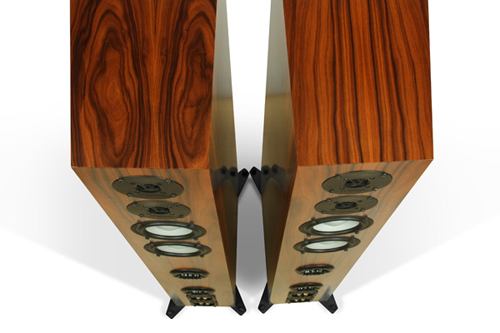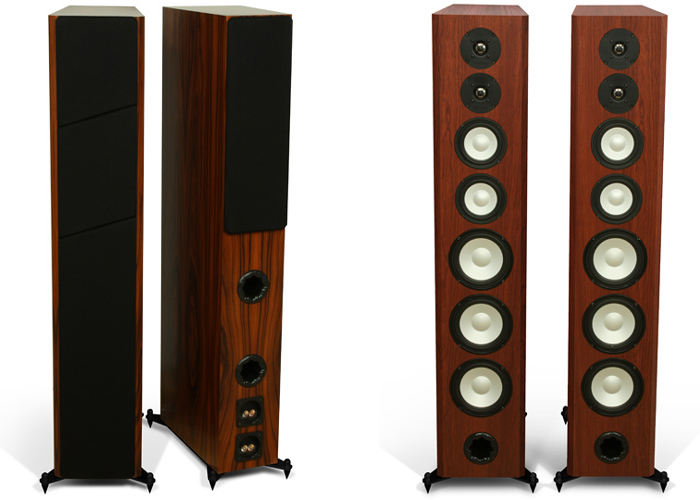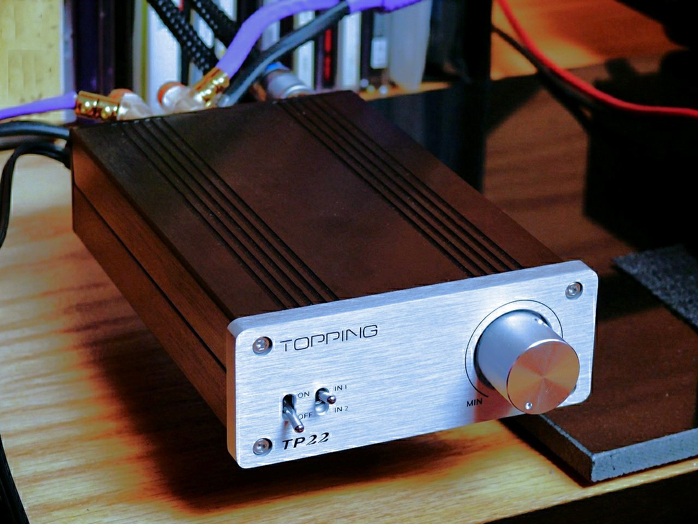This review page is supported in part by the sponsors whose ad banners are displayed below |
 |
 |
Comparisons. The Axiom flagship obviously attempts to carve out fresh territory by appealing to those who are looking for less restrictive seating and vacillate between traditional boxes and panels.
|
 |
First up for comparison is a stellar example of a modern direct-radiating loudspeaker, the SVS Ultra tower. This floorstander shows how far up the ladder one can climb just shy of $2'000/pr with a sophisticated 3½-way of high power handling, wide dynamics and broad bandwidth. With different methodology the SVS aims at many of the same goals minus omni radiation with DSP control. Does the additional cost of the Axiom bring more to the table? Both delve quite deep into the bass with comparable dynamics but where the Ultra goes a bit lower, the Axiom demonstrated superior control. |
|
Both are happy to go loud where the Axiom has a small advantage in efficiency. Both excel at midrange purity. The treble on either exhibits textbook virtues from wide-dispersion metal domes. The Ultra overall sounded perhaps a bit more damped. On imaging the SVS went for slightly better focus against the omni’s huge soundstage. Image size was more consistent with the Axiom although consistently larger too. Front-to-back layering vs. projection were mildly different. The Ultra was a little less upfront whilst the LFR played the omni advantage with a larger stage. The listening window or sweet spot was much wider with the Axiom but critical listening still required that both were treated as more restrictive. On balance the jump in price does offer legitimate gains mainly in the performance parameters specific to omnis.
Against thin-film dipole designs the equivalent price of comparison in the Magnepan line falls between the 1.7 and 3.7. The Theos is the closest current Martin Logan and somewhat more expensive. The long discontinued Apogee Acoustics Centaur would be another viable contender. The one point where panels still have an advantage is responsiveness. ESLs, ribbons and planarmagnetics simply react faster and reveal greater micro detail to create a richer more transparent sonic picture with superior low-level dynamic contrasts. The Axiom is hardly deficient here and represents an extremely well-done cone/dome designs. And absolutes in any single discipline do not a successful speaker design make. Let’s look further.
|
|
|
|
For some, bass is the make/break situation especially for a beefy floorstander. Here the Axiom delivers the hands-down deeper more powerful response with integration that surpasses most hybrids and cohesiveness close to that of a full-range panel. On the ability to fill a room with a massive detailed soundstage, the Axiom competes against all alternatives and remains more forgiving of seating position. It can be bettered in focus by some designs that achieve line source radiation but remains very close. On SPL the Axiom is designed to play loud. The others are more 'audiophile' by nature and thus tamer. By reputation panels are also more difficult to drive and very power hungry. The Axiom is easier to drive but does demand four channels of amplification. The overall scorecard? If your Holy Grail is the pursuit of resolution, go thin film. Otherwise the LFR1100 will offer a presentation the thin film crowd itself will applaud.
|
 |
The M22v3's exceptional dynamic nuance makes it worthy of diverse comparisons. A contender to mind is the fabulous Usher S-520. It performs well above its similar price tag on many levels, with a superb midrange married to the sweetness and detail a silk dome tweeter brings to the equation. Add to that 52Hz bass from a 5” woofer in a compact box. As a standalone speaker the Usher goes lower with more warmth but shows restrictions on achievable volume. The Axiom plays opposite strengths with greater useable power handling and dynamics but more limited bass response. Both manufacturers offer solutions. Usher’s answer is the SW-520, a dedicated woofer system that extends range and dynamics and turns the monitor into a svelte floor stander with considerably more impact and response down to 38Hz. Axiom’s approach is a subwoofer to take advantage of the M22’s superior dynamic ability. Sweetness and warmth go to the Usher, dynamic impact to the Axiom. Both can be satisfying choices with bass capability swaying your decision in standalone mode and bass upgrade potential making for some interesting possibilities in a more advanced configuration.
|
|
|
|
|
|
As the systems were powered down and the boxes readied for packing, 'twas time to muse on the Axiom experience. Ian Colquhoun and Andrew Welker set out to cover much ground with these two designs, one budget, one a modestly priced SOTA effort that radically rethinks bipolar technology to emulate the omni-directional ideal. Have they been successful?
|
 |
The M22v3 can do a lot with very little as the Topping 22 proved. Within its limits it engages with dynamic abandon. Where the Axiom monitor falls short is in absolutes of refinement where higher tiers deliver a bit more data in more coherent fashion; and obvious shortcoming of intentionally limited bass response. The latter is clean and quick as far as it goes but any listener who demands extension will find the M22v3 too lightweight and should either pursue a different model or augment it with a sub. Where the M22v3 shines is in a 2.1 and up setup where its strengths are unleashed without reservation. The engaging dynamic liveliness and clean power handling find new context when bass foundation is a match. Overall performance in this arrangement becomes a worthy alternative to a floorstanding solution and with proper ancillaries can outmatch it on some points. For those listeners who embrace this approach, this is an easy recommendation.
The LFR1100-HP ups the ante of what to expect from Axiom and sets the guidelines for what can be achieved with an advanced bipolar design. The fact that it was able to mimic the soundstaging chops of the Apogee Duetta Signature over an equivalently large listening area should give pause. The LFR drivers were sufficiently seamless to create a cohesive wavefront that didn’t draw attention to any portion of the spectrum and the Titanium tweeters eventually played coy about their metallic nature without losing detail. The speakers played in satisfying fashion at both soft and loud listening levels with wide dynamic range and high SPL potential. |
|
Weaknesses? They fall short of SOTA absolutes in resolution and transient speed by being mildly forgiving. Those who need more must look in the higher financial strata. The rest will deem these 'weaknesses' inconsequential against a convincing column of strengths that honor music as the first priority. At less than $4'500/pr this flagship includes a tank-like external DSP controller and kicks both delicate and hard with the soundstage attributes of a big costly panel. Highly recommended.
|
|
 |
Quality of packing: Industrial quality. Double wall cardboard. Thick polystyrene caps and inserts. Separately protected polystyrene compartments for accessories where applicable. Removal from box per instructions requires minimum 8 foot ceiling and is considerably easier to accomplish with assistance.
Reusability of packing: Reassembling of packing material needs the help of a friend or two.
Condition of components received: Perfect.
Delivery: Picked up from the factory in Dwight, Ontario/Canada
Website comments: Extensive product range with a vast array of customizable options. Customer support includes expert consultation, room analysis and worldwide forum membership.
Human interactions: Approachable and informative.
Warranty: Warrantied against defects for 5 years.
Final comments & suggestions: Two unconventional approaches that take full advantage of the current state of technology. One is to marry into a subwoofer prolific world. The other is to rethink bipolar for the 21st century. Both are highly successful.
|
 |
 |
|
 |